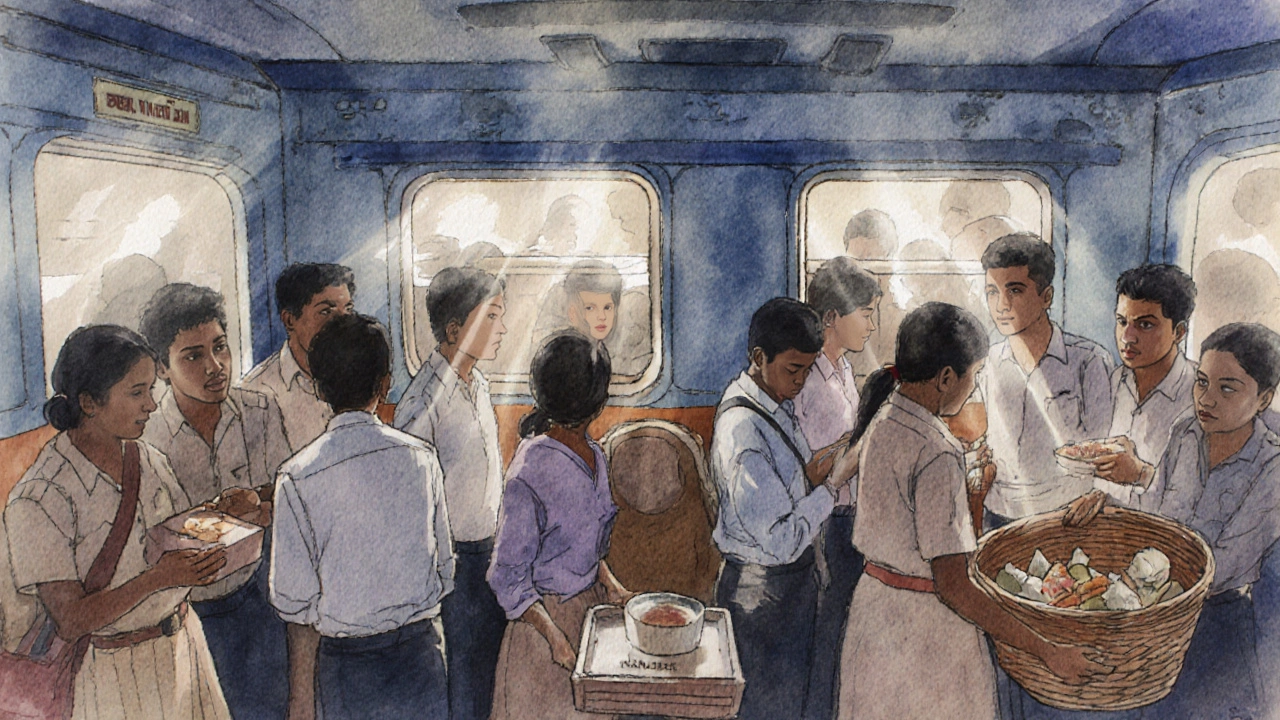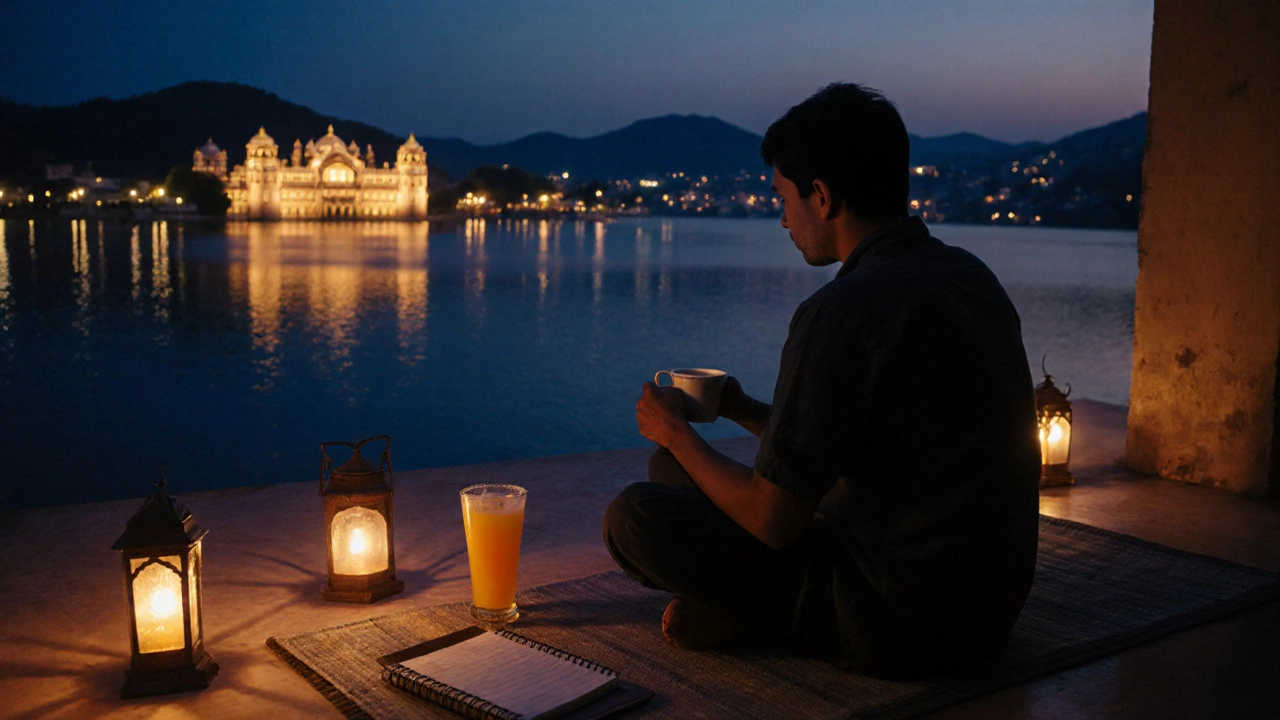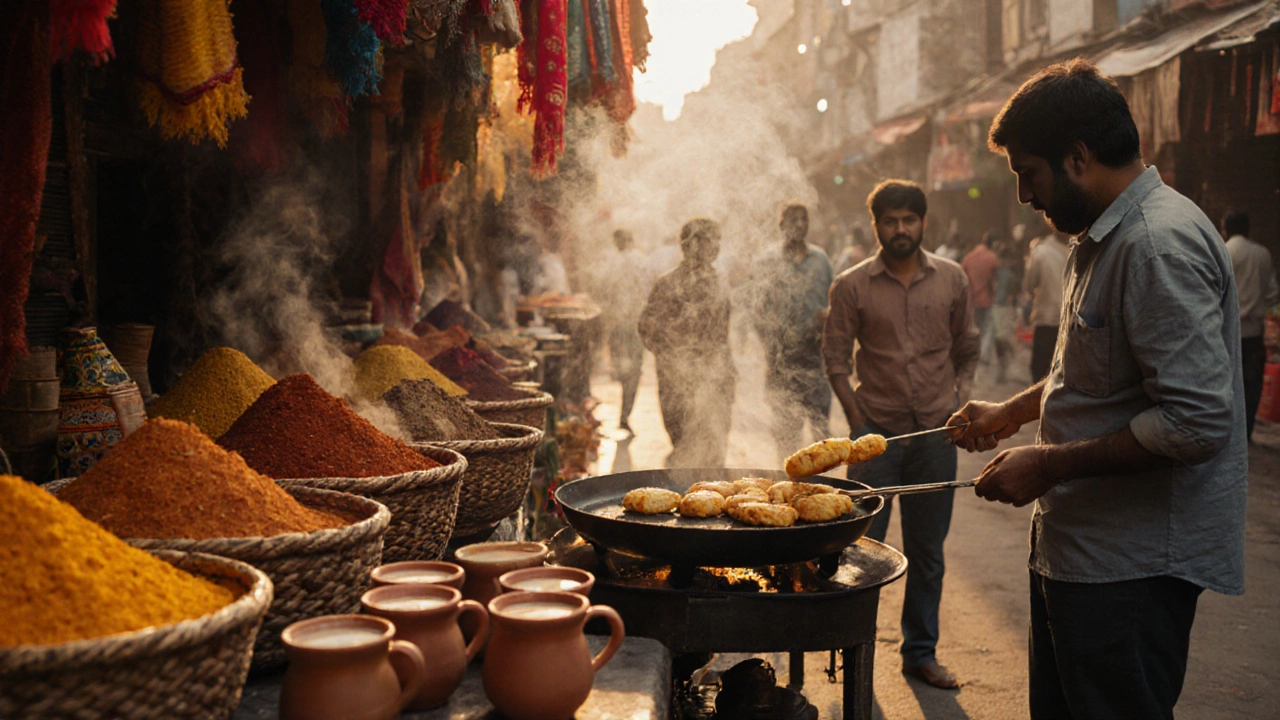India Budget Calculator
Your Daily Budget
India Budget Insights
- 3-4 local meals
- 5+ local transport rides
- 1 budget stay
- Free attractions or under $2 sites
Your Total Daily Cost
Twenty dollars doesn’t sound like much anywhere these days. But in India, it can buy you more than you think - if you know where to look. I’ve watched travelers from the U.S. and Europe stare in disbelief when they realize $20 can cover a full day of food, transport, and even a night’s stay in some parts of the country. This isn’t a fantasy. It’s what happens when you skip the tourist traps and live like the locals.
Food: Eat Like a Local for Under $5
One of the biggest surprises for first-time visitors is how cheap real Indian food is. In a small town in Rajasthan, I ate three meals for under $3. Breakfast was a plate of poha with chai - a flat rice dish cooked with turmeric, peanuts, and lemon - served on a banana leaf. Lunch? A thali: rice, dal, two curries, yogurt, and roti, all on one steel plate, for $1.50. Dinner was a bowl of dal chawal from a street cart, eaten on a plastic stool, for 80 cents.
Street food isn’t risky if you follow two simple rules: watch it being cooked fresh, and go where locals line up. Avoid places with no customers. In Varanasi, I ate samosas filled with spiced potatoes and peas for 15 cents each. In Chennai, a masala dosa - a crispy fermented rice crepe stuffed with potatoes - cost 30 cents. Even in Delhi, a plate of chole bhature (spicy chickpeas with fried bread) ran me $1.50. You can eat well, eat often, and stay full without touching $5.
Transport: Ride Like a Local for Less Than $2
Getting around India doesn’t need a taxi. In fact, taxis will drain your budget fast. Auto-rickshaws are the backbone of local transport. In Jaipur, I rode from my guesthouse to the Amber Fort for $1.20. The driver didn’t use the meter, but I’d already learned the going rate from my host. In Mumbai, I took a local train during rush hour - packed shoulder-to-shoulder with students, office workers, and vendors - for 15 cents. The train ran every 5 minutes and got me across the city in 40 minutes.
Buses are even cheaper. In Kerala, I took a state-run bus from Kochi to Alleppey - a 90-minute ride through backwaters and coconut groves - for 60 cents. In smaller towns, shared jeeps or Tata Sumos (open-sided vans) cost less than $1 for trips up to 20 miles. In rural areas, you might even catch a bicycle rickshaw for 20 cents. The key? Learn the route, know the price range, and don’t be afraid to haggle politely. A $20 budget gives you 10-15 local rides. That’s enough to explore a whole region.
Accommodation: Sleep for $5-$10 a Night
You don’t need a hotel. In fact, most travelers in India sleep in guesthouses, hostels, or homestays that cost less than $10. In Rishikesh, I stayed in a basic room with a fan, clean sheets, and a shared bathroom for $6 a night. In Goa, a dorm bed in a beachside hostel ran $8. In Varanasi, a private room with a balcony overlooking the Ganges was $9. All included breakfast - usually tea and bread or paratha.
Booking platforms like Hostelworld or Airbnb list budget options, but the best deals are found on the ground. Walk into a guesthouse, ask for a room, and negotiate. Many places don’t even have websites. In Khajuraho, I found a family-run homestay where the owner cooked me dinner for $2 extra. In Ladakh, a room with a view of the Himalayas cost $7 - and the owner gave me a free cup of butter tea. A $20 budget stretches to two nights in most places. In smaller towns, you might even stretch it to three.

Attractions: Most Are Free or Under
India’s biggest draws aren’t the expensive ticketed sites. The real magic is in the streets, temples, and rivers. In Varanasi, watching the sunrise over the Ganges with hundreds of pilgrims burning incense and chanting prayers? Free. In Jaipur, walking through the Hawa Mahal’s shadowed arches costs $1.50 - but you can stand outside and photograph it for nothing. In Delhi, the Humayun’s Tomb complex charges $3 for foreigners, but the nearby Qutub Minar is $10. Skip it. Instead, wander the narrow alleys of Chandni Chowk - spice stalls, brassware, and street musicians everywhere.
Temples are mostly free. In Tamil Nadu, I spent an entire afternoon at the Meenakshi Temple in Madurai - gold-plated towers, drummers, flower sellers, and priests blessing visitors. No fee. In Rajasthan, I climbed the steps of the Jaisalmer Fort for $1.50, but the view from the top - golden sandstone buildings under a blue sky - was priceless. Even in Mumbai, the Siddhivinayak Temple doesn’t charge entry. You can spend hours there, watching devotees, lighting lamps, and eating free prasad (blessed food).
What $20 Can’t Buy
Let’s be clear: $20 won’t cover flights, luxury stays, or guided tours with English-speaking drivers. It won’t get you a bottle of imported beer or a fancy restaurant dinner. It won’t cover a 10-hour train ride in AC class. But that’s not the point. This budget isn’t about comfort. It’s about immersion.
If you’re trying to see India’s soul - the rhythm of daily life, the smell of cardamom in the morning, the sound of temple bells at dusk - then $20 is more than enough. It forces you to slow down. To eat where the locals eat. To ride where they ride. To sleep where they sleep. And that’s when you stop being a tourist and start living like someone who belongs.
Real Example: One Day with $20 in Udaipur
Here’s how $20 played out in Udaipur on a weekday:
- Breakfast: Masala chai and a plate of vada pav ($0.60)
- Transport: Auto-rickshaw to City Palace entrance ($1.20)
- Entry: City Palace ticket ($3)
- Lunch: Thali at a local eatery ($1.50)
- Afternoon: Walk along Lake Pichola, watch boats, take photos (free)
- Dinner: Dal fry, roti, and mango lassi from a street vendor ($1.80)
- Transport: Walk back to guesthouse (free)
- Accommodation: Dorm bed at a backpacker hostel ($8)
Total spent: $16.10. Leftover: $3.90. I used it to buy a handmade paper notebook from a local artisan. That night, I sat on the rooftop, sipping tea, watching the lights flicker on the lake. No Wi-Fi. No fancy restaurant. Just silence, stars, and the feeling that I’d just lived a full day on less than most people spend on coffee.

Where Goes Further
The farther you get from big cities, the more your dollar stretches. In Bihar, a meal costs half what it does in Delhi. In Odisha, a night in a homestay near Puri is $4. In Himachal Pradesh, shared taxis between villages run 30 cents. In the Himalayan foothills, you can find guesthouses that don’t even charge for water - you drink from the spring.
Even in tourist-heavy spots like Goa or Kerala, you can still find pockets where $20 lasts. Skip the beach clubs. Eat at the fish stalls by the harbor. Ride a local bus instead of a private driver. Sleep in a simple room with a mosquito net. You’ll still see the same sunsets, hear the same waves, taste the same spices - just without the markup.
How to Make $20 Last
- Carry small bills. Many vendors don’t have change for $20.
- Drink tap water only if filtered. Buy bottled water in bulk - a 1-liter bottle costs 20 cents.
- Use free Wi-Fi at cafes or libraries. Don’t buy a local SIM unless you need it.
- Walk. Most sights in small towns are within 2 miles of each other.
- Ask locals where they eat. If they point to a place with no English signs, go there.
- Travel off-season. In winter, prices drop 30-50% in most hill stations.
Final Thought: It’s Not About the Money
$20 isn’t the goal. The goal is connection. It’s tasting food made by someone’s grandmother. It’s sharing a ride with a family heading home after a wedding. It’s sleeping under a fan, listening to the hum of the city outside your window.
India doesn’t reward those who spend the most. It rewards those who show up with curiosity, respect, and an open wallet - not an empty one.
Can I survive on $20 a day in India?
Yes, if you stick to local food, public transport, and budget stays. Most travelers spend $15-$25 a day in smaller towns and rural areas. In big cities like Mumbai or Delhi, $20 is tight but doable if you avoid tourist restaurants and taxis.
Is $20 enough for a week in India?
For one week, $140 can cover food, transport, and lodging in most places outside major cities. But you won’t be able to afford long-distance train tickets or entry to expensive sites like the Taj Mahal ($15 for foreigners). If you’re planning to travel between states, add $50-$100 for transport.
What’s the cheapest city in India for travelers?
Varanasi, Rishikesh, and Bhubaneswar are among the cheapest. Food, lodging, and transport cost 30-40% less than in Delhi or Goa. Rural areas in Bihar, Jharkhand, and Odisha are even cheaper - but infrastructure is basic.
Do I need to carry cash in India?
Yes, especially in small towns. Many street vendors, guesthouses, and auto-rickshaw drivers don’t accept cards or digital payments. ATMs are common in cities, but they often run out of cash or charge high fees. Carry small rupee notes - 10, 20, 50, and 100 rupee bills are your best friends.
Can I drink alcohol on a $20 budget in India?
Not easily. A local beer costs $2-$3 in a bar. A bottle of Indian whiskey is $5-$8. If you’re on a strict $20/day budget, skip alcohol. It’s not worth the cost. Many budget travelers find they enjoy the experience more without it - the flavors of food, the rhythm of the streets, and the warmth of strangers become more vivid.
